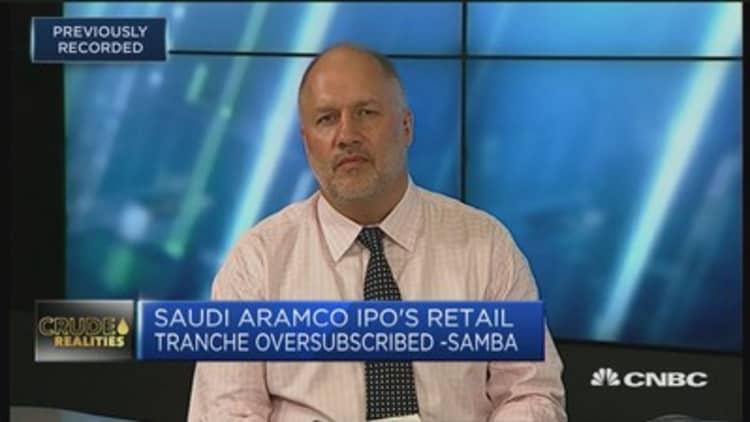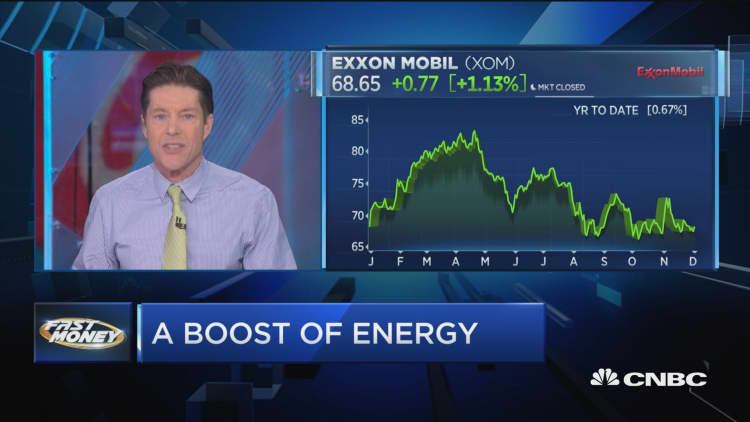DUBAI — Saudi Arabian Oil Co., or Saudi Aramco, priced its IPO at 32 riyals ($8.53) per share — the top of its indicative range — which puts the company on track to raise $25.6 billion.
The state-owned company's public debut will become the largest on record, topping the $25 billion Alibaba raised when it went public in September 2014.
Aramco's initial public offering may have priced at the top of its range, but the $1.7 trillion valuation is below what the kingdom had initially been targeting.
The long-awaited IPO of the world's largest and most profitable company will list locally on the Tadawul, Saudi Arabia's stock exchange, and forms the centerpiece of Crown Prince Mohammed bin Salman's Vision 2030 aimed at transforming the Saudi economy.

The pricing announcement follows a weeklong local roadshow around the Middle East that saw Aramco's local listing oversubscribed by nearly three times, attracting offers worth 189.04 billion riyals ($50.4 billion), according to banks advising the listing. Institutional investors had between Nov. 17 and Dec. 4 to place their orders.
Aramco has said in the past that 0.5% of its listed shares would be available to individual retail buyers, while the remaining 1% would be for institutional investors. That 1% is equivalent to 2 billion shares. In the first 2½ weeks of Aramco's book-building period, it drew subscription orders for 5.9 billion shares.
'A hollow win'
The IPO's size is well short of the crown prince's initial valuation of $2 trillion. The kingdom needed to rely predominantly on local investors after canceling roadshows in London and New York on the back of lackluster international interest.
Ellen Wald, president of Transversal Consulting and author of the book "Saudi, Inc." described the IPO's record size as a "hollow win."
"The local demand from retail investors wasn't as high as (Saudi Arabia) hoped for," Wald told CNBC on Thursday. "The investments were almost entirely local and attracted no money from outside the region, over-subscription was not significant. Most IPOs are over subscribed many more times over and the government had to manufacture demand, even from Saudis."
Aramco did not reply to CNBC requests for comment.
Gulf allies the United Arab Emirates and Kuwait are believed to have made substantial commitments to the Saudi project, with the Kuwait Investment Authority and Abu Dhabi reportedly investing up to $1 billion and $1.5 billion in the public offering, respectively, though they have not commented publicly on the matter.

Samba Capital, one of Aramco's advisors, said in a statement that 10.5% of the offers came from foreign investors, while most were from Saudi funds and companies. Saudi Arabia has also turned to wealthy local families and Saudi billionaires to drum up support for the listing, according to reports.
The oil giant had delayed its IPO, originally scheduled for 2018, reportedly over Saudi concerns about public scrutiny of its finances and because of the complexity of its corporate structure. The crown prince initially touted a valuation of as high as $2 trillion, a figure that was brought down in recent months as financial advisors estimated a valuation closer to $1.5 trillion.
Ahead of the listing, Aramco detailed the vast number of risks its oil and gas business faces in a prospectus released in early November.
More obvious risks include the supply, demand and price of crude or how much oil the Saudi government decides to produce, as the country is the largest producer in OPEC.
Security risks remain high on that list — Aramco's oil production was hit by drone attacks in September, which forced Riyadh to cut output by 50%. It took weeks for the Saudi government to restore capacity. Other risks include climate change and the company's dependence on demand from Asia, its prospectus said.

— CNBC's Hadley Gamble and Pippa Stevens contributed reporting.


